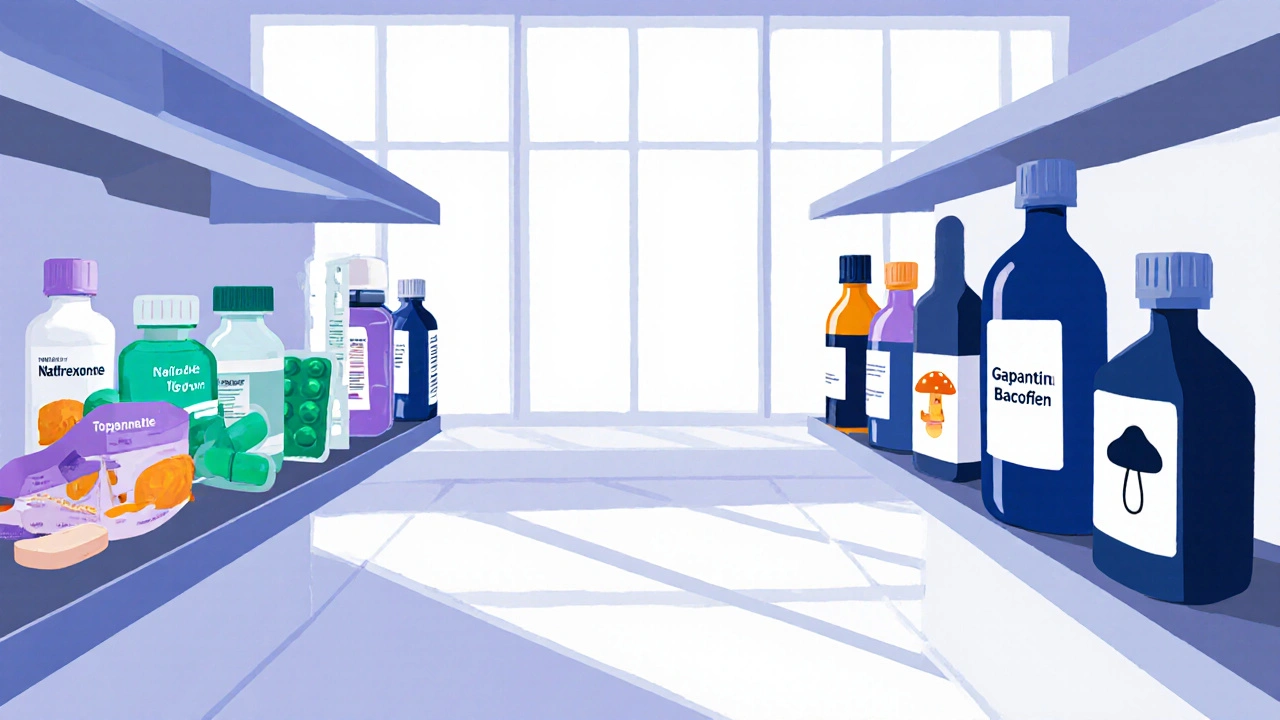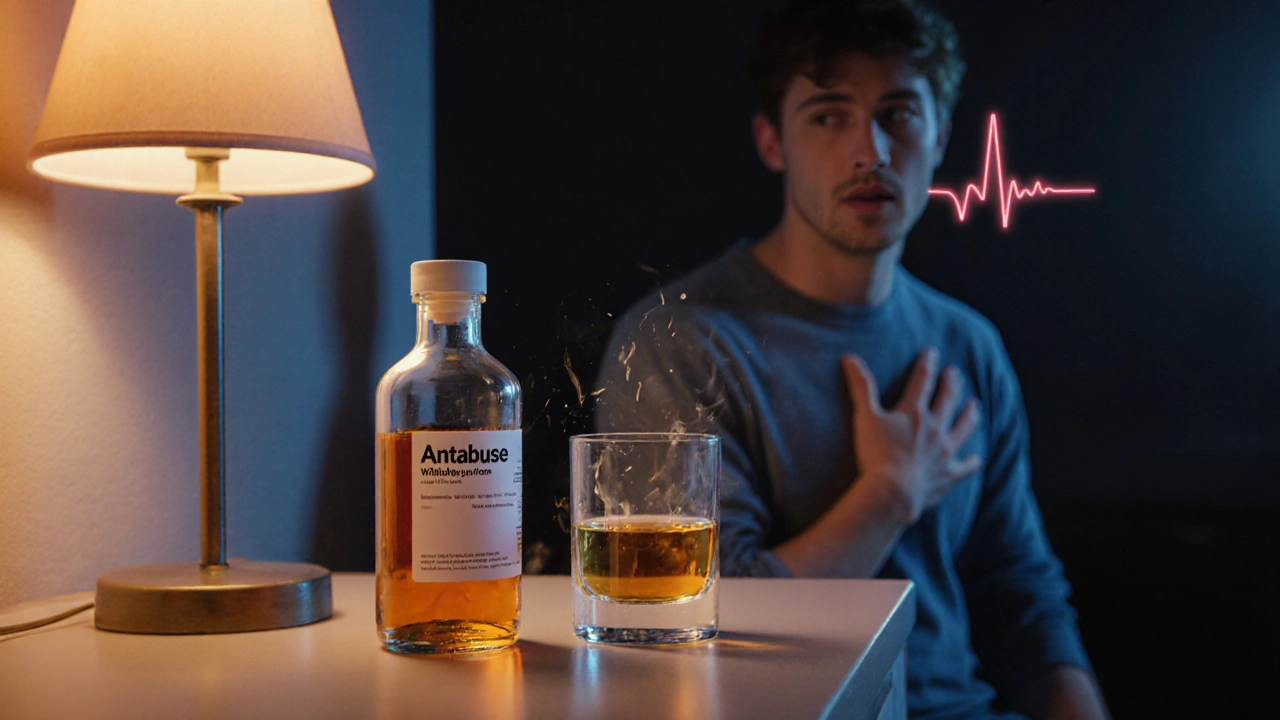AUD Medication Comparison Tool
Medication Details
Select a medication to view details
Match Recommendations
Select a medication and situation to see recommendations
If you or someone you know is trying to stay sober, the medication choice can feel like a maze. One popular option is Antabuse, but there are several other drugs that claim to help keep the drink away. This guide breaks down Antabuse (Disulfiram) side‑by‑side with its main competitors, so you can see which one fits your lifestyle, health profile, and recovery goals.
What is Antabuse (Disulfiram)?
When treating alcohol dependence, Antabuse is a synthetic drug that creates an acute physical reaction if alcohol is consumed. The active ingredient, Disulfiram, blocks the enzyme aldehyde dehydrogenase, causing acetaldehyde to build up after a drink. The result is flushing, rapid heartbeat, nausea, and sometimes vomiting - a reaction that lasts 30 to 60 minutes and serves as a strong deterrent.
Typical dosing starts with a 500mg loading dose on day one, followed by a maintenance dose of 250mg daily. Physicians usually prescribe it after a period of abstinence, ensuring the patient can handle the potential reaction. Clinical trials report a relapse reduction of roughly 30% compared with placebo, especially when combined with counseling.
Pros of Antabuse include its clear, immediate deterrent effect and low cost. Cons involve the need for strict adherence (missing a dose can reduce effectiveness), the uncomfortable physical reaction, and contraindications for people with heart disease, liver problems, or certain psychiatric conditions.
Key Alternatives to Antabuse
Below are the most commonly prescribed medications for Alcohol Use Disorder (AUD). Each entry introduces the drug with a micro‑data block, highlighting its mechanism, typical dose, and who it helps most.
Naltrexone is an opioid‑receptor antagonist that blocks the rewarding effects of alcohol, reducing cravings. The usual oral dose is 50mg once daily, while an extended‑release injectable (Vivitrol) offers a monthly 380mg injection. Studies show a 20‑30% drop in heavy‑drinking days when used with psychosocial support.
Acamprosate works by restoring the balance of glutamate and GABA in the brain, easing the post‑withdrawal stress that fuels relapse. The standard regimen is 666mg three times daily. It’s especially helpful for people who have already achieved abstinence and need a maintenance aid.
Topiramate is an anticonvulsant that also dampens dopamine release associated with alcohol’s pleasure response. Doses start low (25mg) and are titrated up to 200mg per day. Research indicates a 40% reduction in drinking days, though cognitive side effects like word‑finding trouble can be a hurdle.
Gabapentin modulates calcium channels, easing anxiety and sleep disturbances that trigger drinking. A typical dose ranges from 300mg to 1,200mg daily, divided into three doses. It’s often chosen for patients with co‑occurring neuropathic pain or insomnia.
Baclofen is a GABA‑B agonist that reduces cravings by calming the brain’s reward circuit. Started at 5mg three times a day, it can be increased to 30‑40mg daily. While evidence is mixed, many patients report a smoother transition to sobriety.
Varenicline (originally a smoking‑cessation aid) has shown promise for reducing alcohol cravings by partially stimulating the same nicotinic receptors. The usual dose is 1mg twice daily after a titration period.
Psilocybin‑assisted therapy is an emerging, investigational approach where a supervised psychedelic session is combined with psychotherapy. Early-phase trials report dramatic reductions in drinking, but it remains off‑label and not widely available.

Side‑by‑Side Comparison
| Medication | Mechanism | Typical Dose | Evidence of Efficacy | Common Side Effects | Best For |
|---|---|---|---|---|---|
| Antabuse (Disulfiram) | Aldehyde dehydrogenase inhibition → acetaldehyde buildup | 500mg loading, then 250mg daily | 30% relapse reduction (meta‑analysis 2022) | Flushing, headache, metallic taste | Highly motivated patients wanting a deterrent |
| Naltrexone | Opioid‑receptor antagonist → blocks reward | 50mg PO daily or 380mg IM monthly | 20‑30% fewer heavy‑drinking days (Cochrane 2023) | Nausea, liver enzymes elevation | People who struggle with cravings |
| Acamprosate | Glutamate/GABA modulation → reduces post‑withdrawal stress | 666mg PO three times daily | 15‑25% increase in abstinent days (meta‑analysis 2021) | Diarrhea, abdominal pain | Patients already abstinent seeking maintenance |
| Topiramate | Enhances GABA, inhibits glutamate → dampens dopamine | 25‑200mg PO daily (titrated) | ~40% reduction in drinking days (RCT 2020) | Cognitive fog, weight loss, paresthesia | Patients needing strong craving control, tolerable cognitive impact |
| Gabapentin | Calcium‑channel modulation → reduces anxiety / sleep issues | 300‑1200mg PO daily (divided) | 10‑20% reduction in relapse rates (pilot 2022) | Dizziness, edema, fatigue | Individuals with co‑occurring pain or insomnia |
| Baclofen | GABA‑B agonist → suppresses craving circuitry | 5‑40mg PO daily (titrated) | Mixed results; ~15% benefit in select trials | Muscle weakness, drowsiness | Patients needing a low‑cost oral option |
| Psilocybin‑Assisted Therapy | Serotonergic psychedelic experience → re‑wires maladaptive patterns | One supervised high‑dose session (25mg psilocybin) + integration | Early trials show >60% sustained abstinence at 6months | Transient anxiety, nausea (clinical setting only) | Highly selected patients, under specialist care |
How to Choose the Right Medication
- Medical clearance: Liver function, heart health, and psychiatric history dictate suitability. Antabuse, for example, is unsafe for anyone with significant cardiac disease.
- Motivation style: If you need a strong physical reminder, Antabuse works well. If cravings dominate, Naltrexone or Topiramate may be better.
- Adherence comfort: Daily pills require strict routine. Monthly injections (Vivitrol) reduce daily hassle but cost more.
- Side‑effect tolerance: Cognitive fog from Topiramate or the flushing from Antabuse can be deal‑breakers. Discuss potential impacts with your clinician.
- Cost and insurance coverage: Generic Antabuse and Naltrexone are inexpensive; newer options like Vivitrol or psilocybin trials may involve out‑of‑pocket expense.
Ultimately, the best choice emerges from a conversation between you, your doctor, and, if possible, a substance‑use counselor. Combining medication with therapy, peer support, and lifestyle changes (exercise, structured schedules) yields the highest success rates.

Practical Tips for Managing Medication
- Keep a medication diary - note dose time, any side effects, and alcohol exposure.
- Set daily reminders on your phone or use a pill‑box organizer.
- Never skip a dose without consulting your prescriber; abrupt changes can reduce efficacy.
- Attend regular follow‑up appointments to monitor labs (especially liver enzymes for Naltrexone) and adjust dosing.
- Pair medication with at least one psychosocial intervention: cognitive‑behavioral therapy, SMART Recovery, or a 12‑step group.
Frequently Asked Questions
Can I take Antabuse and Naltrexone together?
Combining the two is generally not recommended because they work on opposite pathways - one creates a deterrent reaction, the other blocks reward. Some clinicians might use a brief overlap during a transition, but it requires close monitoring.
How quickly does Antabuse start working?
The drug needs to build up in the body after the loading dose. Most patients see the deterrent effect within 2‑3 days, but consistent daily dosing is essential for full protection.
Is Acamprosate safe for people with liver disease?
Yes. Acamprosate is eliminated unchanged by the kidneys, so it’s the preferred choice for patients with compromised liver function.
What should I do if I accidentally drink while on Antabuse?
You’ll likely experience severe flushing, nausea, and rapid heart rate. Seek medical attention if symptoms are intense or you feel faint, as dehydration and cardiac stress can occur.
Can any of these medications help with alcohol‑related anxiety?
Gabapentin and Baclofen are often chosen for patients who cite anxiety or sleep problems as relapse triggers. They can calm the nervous system while still supporting abstinence.


Comments (20)
Hey folks, great rundown on the meds – love how you laid out the pros and cons side‑by‑side. If you’re hunting for that solid deterrent, Antabuse really shines, especially on a budget :)
The comparative analysis you present is commendably thorough, yet one must consider the pharmacodynamic nuances inherent to each agent. Disulfiram’s irreversible inhibition of aldehyde dehydrogenase offers a distinct physiological deterrent, whereas agents such as naltrexone function via opioid antagonism. Moreover, the hepatic safety profile is a pivotal determinant for patient selection. Your tabular synthesis adeptly facilitates clinical decision‑making.
Appreciate the clear breakdown. I’ve seen patients who prefer a daily pill over a monthly injection, so the dosing frequency info is handy. The table makes a quick glance easy.
Thank you for the meticulous guide. It is especially useful for those navigating insurance constraints, as you noted the cost differences. The inclusion of side‑effect profiles aids shared decision‑making. Well done.
Interesting how each medication targets a different pathway in the brain’s reward circuitry. For someone battling cravings rather than seeking a deterrent, naltrexone or topiramate might be a better fit. Also, the liver enzyme concerns with naltrexone are worth flagging early. Overall, a solid comparative chart.
Disulfiram’s deterrent effect is blunt but effective when compliance is strict. Gabapentin shines for sleep‑related relapse triggers.
Wow, another “miracle” pill, sure.
Colorful table, love the vibe! Still, remember that "one size fits all" never applies in AUD treatment. The real challenge lies in marrying these meds with human support systems. Keep the creativity flowing.
Great summary, especially the part about medication diaries – simple habit that makes a huge difference. Pairing meds with therapy is the sweet spot. Thanks for sharing.
All these drugs sound like they’re from a pharma playbook. You never hear about the “real” side effects the media hides.
The syntax of the guide is mostly sound, yet several commas are misplaced, creating parsing hiccups. For instance, "Disulfiram’s deterrent effect is blunt but effective when compliance is strict" could benefit from a pause after "blunt". Also, the term "low‑cost" should be hyphenated consistently. Overall, a minor editorial polishing would elevate readability.
Nice overview, the tables are helpful. The dosage info is clear and concise.
Whoa!!! This guide packs a punch!!! Really love the way you laid out each drug’s pros and cons!!! The visual table is super‑useful!!! Keep cranking out this gold!!!
Thanks for the thorough chart! 👍 The side‑effect list helped me prep a question for my doctor. 😊
Excellent compilation of current pharmacotherapies. The structured format lends itself well to a quick consult. I appreciate the emphasis on liver safety, particularly for naltrexone. This will be a valuable reference for clinicians.
Alright, let me unpack this massive spreadsheet of hope and hype. First off, you’ve done a solid job of aggregating data, but the devil’s always in the details, and I’m going to pick those apart. Disulfiram, you say, has a 30% relapse reduction – sure, but that number hinges on perfect adherence, which in the real world is a fantasy. You can’t expect patients to swallow a daily pill and never miss a dose; life gets messy, and when they slip, the deterrent effect evaporates faster than a cheap bottle of whiskey. Naltrexone’s 20‑30% drop in heavy‑drinking days sounds decent, yet the liver enzyme elevation warning is a red flag for anyone with even a hint of hepatic trouble – you’ve glossed over that risk. Acamprosate gets a nod for safety in liver disease, but three pills a day? Compliance drops like a stone, especially for people already battling cravings. Topiramate’s cognitive fog is more than a “side effect”; for a diligent professional, that fog can ruin a career, yet the guide seems to downplay it. Gabapentin is painted as a sleep‑aid for co‑occurring pain, but the risk of dependence and abuse isn’t mentioned – the opioid crisis taught us to read the fine print. Baclofen’s mixed results get a brief shrug; let’s be honest, the literature is a mess, and you’d be wise to advise patients to view it as a gamble, not a guarantee. Psilocybin‑assisted therapy is the shiny new toy; the early data is promising, but the legal and ethical quagmire is massive – you can’t just hand a patient a schedule‑II psychedelic without cautioning them about the lack of regulation. Also, the cost factor comes up briefly, yet insurance coverage for many of these meds is a nightmare that can derail treatment plans before they even start. You mention “pairing medication with therapy,” which is vital, but the guide doesn’t dive into which psychotherapies synergize best with each pharmacologic choice. For instance, Cognitive‑Behavioral Therapy has strong evidence with naltrexone, while Motivational Interviewing pairs well with Antabuse’s deterrent model. Lastly, the table is dense – nice for clinicians, but a layperson might feel overwhelmed. A simple “which drug for me?” flowchart could save a lot of scrolling. All in all, solid foundation, but the devil’s in the nuance, and that’s where real success or failure lives.
Wow, another post glorifying pharma – as if pills solve everything. Sure, let’s just trust the big pharma gospel.
Another “expert” guide, more like a marketing brochure. Check the sources before you trust.
Disulfiram is a great option, but dont dont forget about the heart risks. Also, naltrexone is good, but watch out for livers.
This guide looks sleek, yet the real world is messy – compliance, cost, side‑effects all matter. A simple flowchart would be a nice add‑on.